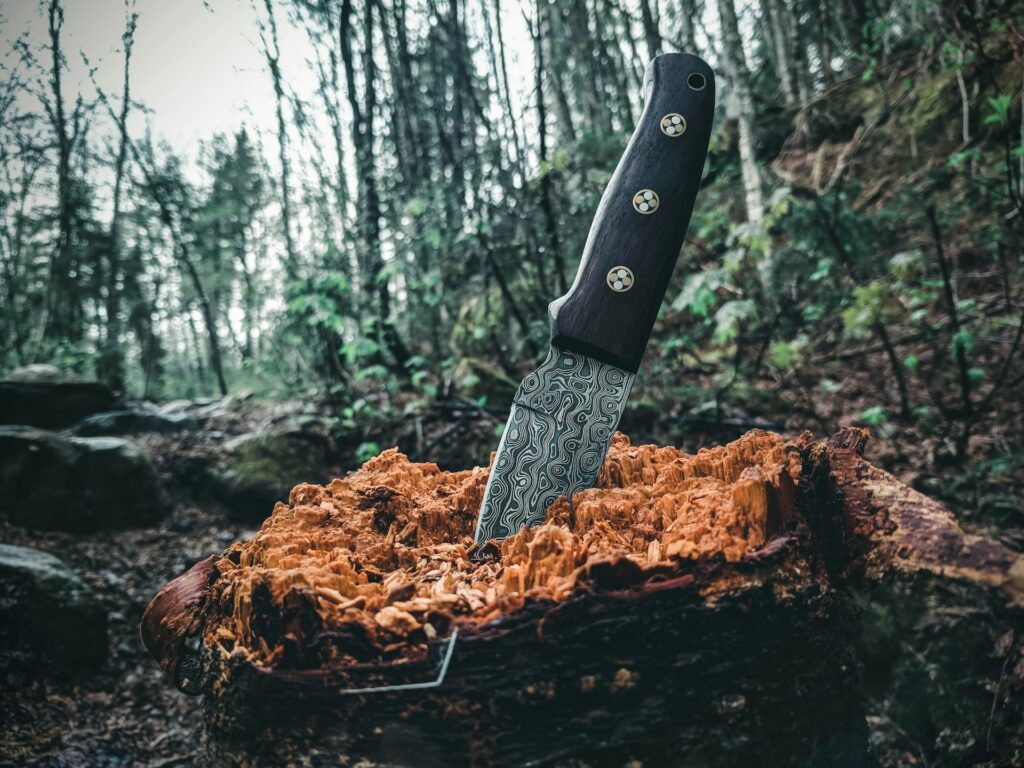
Camping knives come in a variety of shapes and sizes, designed to meet any outdoor need. Fixed blade knives are great for heavy-duty tasks such as chopping wood or clearing brush, while folding blade knives offer the convenience of portability.
Additionally, there are several types of blade materials to consider when choosing a camping knife including carbon steel, stainless steel, and ceramic.
Lastly, it is important to select a knife with an ergonomic handle for comfort and grip, such as one made of wood, synthetic material or metal. With the right camping knife you will be prepared for any outdoor activity!
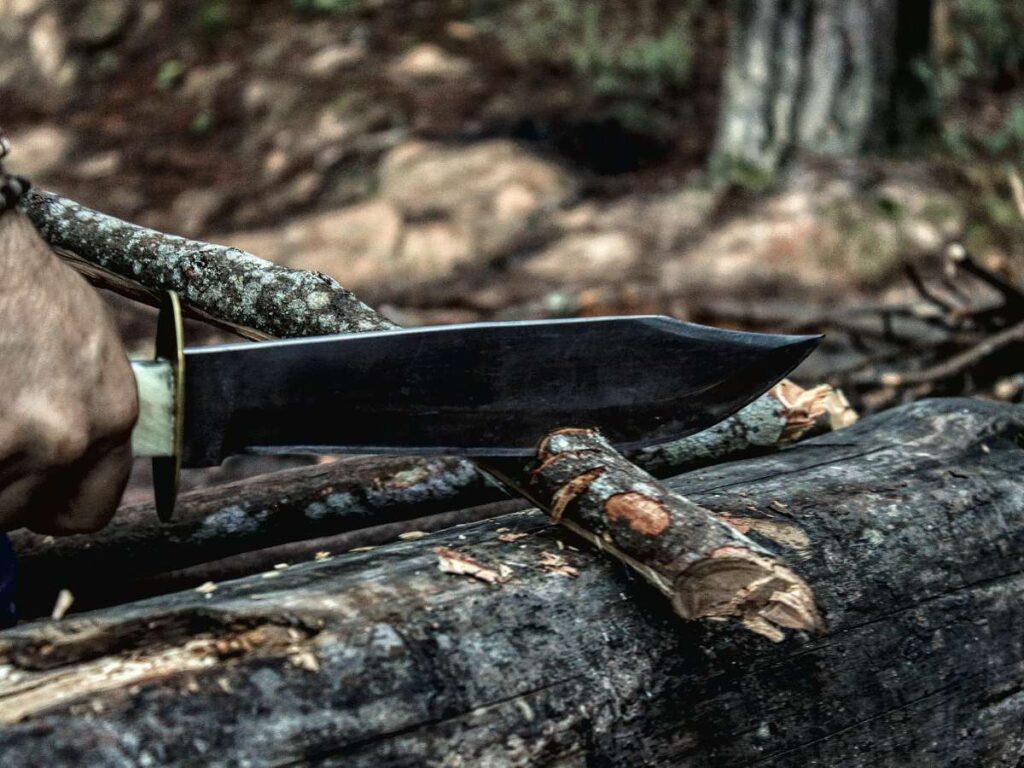
Camping knives are an essential piece of equipment for any outdoor excursion, and there are a variety of styles to choose from. Fixed blades have become increasingly popular amongst experienced campers, as they provide maximum strength and durability.
For those looking for something lightweight and affordable, the Mora Companion is a great choice that can tackle whittling or food prep with ease thanks to its slim profile and high carbon steel construction.
The ESEE-6 offers a higher performance alternative, designed for those who need something reliable yet still prefer the affordability of a lesser-known brand.
Finally, when you are in need of an all-purpose utility tool ultimate knife that can handle anything outdoors, nothing beats the KA-BAR Becker BK2. This knife comes with a heavy duty sheath, making it easy to carry in even the toughest environments.

Folding knives, also known as pocket knives, are quite popular due to their lightweight design and portability for everyday carry.
They feature a blade that can be folded into the handle which is often smaller and more compact than fixed blade knives.
Three of the most notable examples are Benchmade Griptilian, that comes with various useful features such as ambidextrous thumb studs; Spyderco Paramilitary 2, a classic high-performance option with a slim profile; and Victorinox Swiss Army Classic knife, essential for everyday carry knives and tasks.
Although convenient, folding knives may not offer the same sturdiness as a fixed blade knife so choose based on usefulness for your needs.
The Leatherman Wave Plus is the only multi-tool you will need. It includes essential tools for any task, such as car work or home improvements, and is easy-to-use with outside-accessible features. This durable multi-tool also features replaceable wire cutters, regular and needlenose pliers, a powerful 7.37 cm lockable 420HC stainless steel blade, and a 420HC serrated knife. Leatherman multi-tools come with everything you need for all jobs around the house or for setting up a campsite.
The Victorinox Hunter XT Pocket Knife was specially designed to accompany hunters and serious outdoor enthusiasts. The oval thumbholes on each blade enable one-handed opening of the blades, while the two-component compound on the scales ensure excellent grip. And thanks to the curved shape and rounded tip of the special gutting blade, game can be dressed quickly and easily right there in the field.
The Gerber Suspension-NXT Multi-Tool is a 15-tool powerhouse designed for everyday carry. Its smart butterfly design features outboard tools that are accessible in a snap, making it the perfect tool for unexpected tasks. The Needle nose plier, Regular plier, Wire cutter, and 2.25in Plain / Serrated combination blade are all made of stainless steel and are heat treated for added strength and durability.
Multi-tools are an incredibly versatile item, combining a knife with pliers, scissors, and screwdrivers. This feature makes them perfect for campers who want to limit their items but need a range of tools; one multi-tool contains the functionality of folding knife and multiple separate tools.
The Leatherman Wave+ is a popular and versatile multi-tool, well-suited for outdoor and camping activities.
It features 18 tools, including pliers, wire cutters, a 420HC stainless steel knife, a serrated knife, a saw, spring-action scissors, and various screwdrivers.
The Wave+ is known for its durability, high-quality construction, and user-friendly design, with most tools being accessible from the outside, allowing for easy one-handed use.
This multi-tool is an excellent choice for campers who need a reliable and comprehensive set of tools for various tasks.
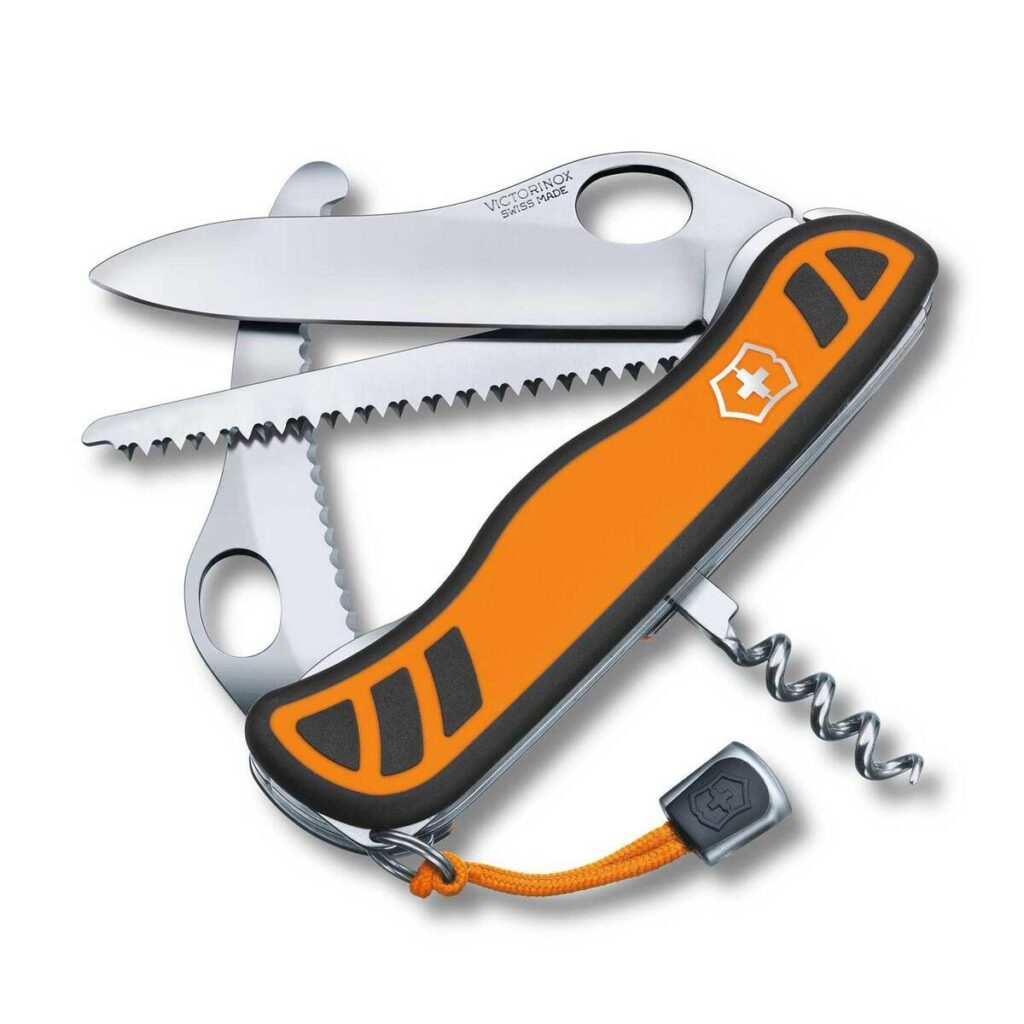
The Victorinox Swiss Army Huntsman is a classic multi-tool designed for outdoor enthusiasts. It features 15 functions, including a large blade, small blade, wood saw, scissors, can opener, bottle opener, and various screwdrivers.
Made from high-quality stainless steel, the Huntsman is compact, lightweight, and offers excellent corrosion resistance.
With its iconic design and a wide range of useful tools, the Swiss Army Huntsman is a popular choice for camping and outdoor adventures.
The Gerber Suspension Multi-Plier is a sturdy and functional multi-tool designed for outdoor use. It features 12 tools, including needle-nose pliers, wire cutters, plain and serrated knives, a saw, scissors, a can opener, and a bottle opener.
The Suspension Multi-Plier boasts a unique butterfly-opening design with a comfortable grip and a durable, lightweight aluminum frame.
Its Saf.T.Plus locking system ensures that each tool locks in place for safe and secure use. The Gerber Suspension Multi-Plier is a reliable and budget-friendly option for campers who need a versatile set of tools for various outdoor tasks.

Selecting the best camping knife involves understanding different blade shapes and their specific uses.
Each blade shape excels in certain tasks, so considering your needs and preferences is essential. Here are some common blade shapes and their applications in a camping context:
A drop point blade features a convex curve that slopes from the spine to the tip of solid knife, creating a strong, versatile point.
This design is ideal for a variety of tasks, including slicing, chopping, and piercing. Drop point blades are popular among outdoor enthusiasts due to their all-around utility, making them a great choice for general camping use.
Clip point knife blades often have a concave curve near the tip, creating a sharp, precise point. The fine tip excels in tasks that require precision, such as skinning game or carving wood.
However, the narrow tip may be less robust than other blade shapes when used for heavy-duty tasks.
Clip point knives are suitable for campers who need a versatile knife with an emphasis on precision cutting.
Tanto blades have a straight or slightly curved edge that transitions to a sharply angled, almost triangular tip.
This design results in a robust, reinforced point that excels in piercing tasks. Tanto knives are well-suited for campers who need a sturdy knife for tasks that demand a strong, puncturing tip.
However, they may not be as versatile as drop point or clip point blades for slicing and cutting tasks.
A sheepsfoot blade features a straight edge with a gentle curve near the tip, which aligns with the spine, creating a rounded point.
This design is ideal for tasks that require control and safety, such as slicing food, cutting rope, or whittling wood.
The rounded tip reduces the risk of accidental punctures, making sheepsfoot knives a safe choice for various camping tasks.
Spear point blades have a symmetrical design, with the spine and edge curving towards each other and meeting at a central point.
This shape creates a strong, sharp tip that excels in piercing tasks.
Spear point knives are well-suited for campers who require a compact knife, with excellent puncturing capabilities but may not be as versatile as drop point or clip point blades for general cutting tasks.
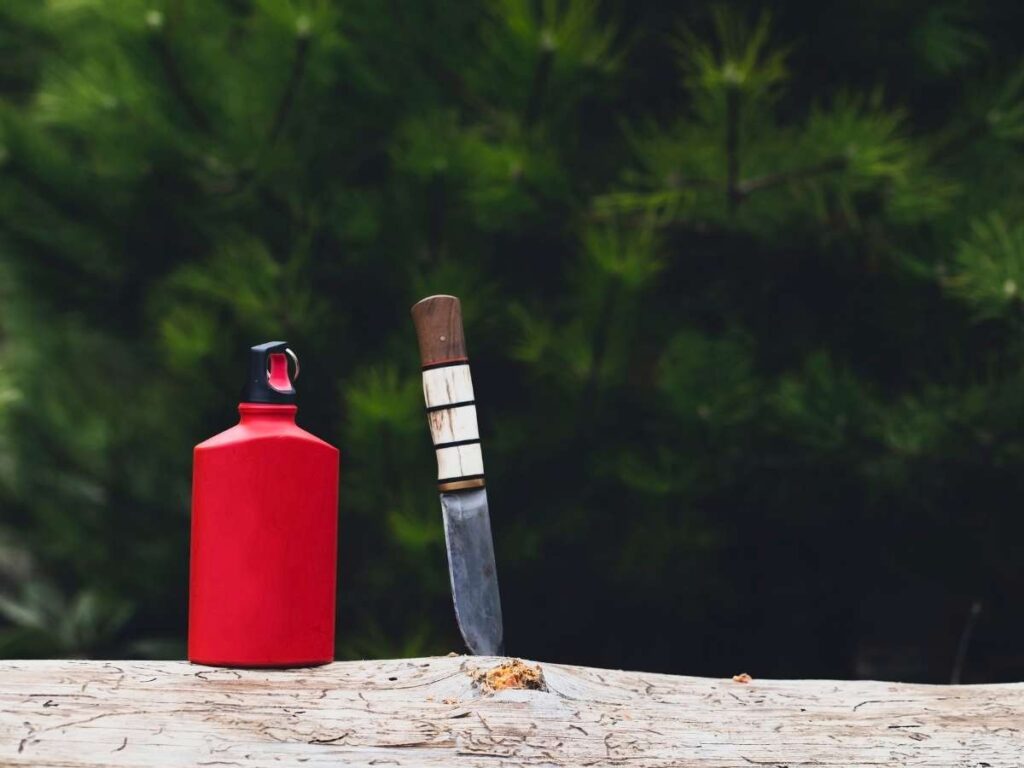
Camping survival knives are essential to any outdoor enthusiast. When finding the right blade, take into consideration the blade material, length, and handle material.
For example, stainless steel blades are more durable, while blades made of other metals will retain their edge better in tough conditions.
Multi-tools that include pliers, scissors, and screwdrivers can also come in very handy during camping trips and the size of the handles need to be considered as well.
All these features combined make for the best camping knife and an invaluable source during all your outdoor escapades.
Choosing the right blade material for a knife can be a difficult process because of all of the factors impacting a knife’s performance, durability, and corrosion resistance. Two popular blade material options are stainless steel and carbon steel.
Stainless steels such as 420HC, VG-10, and S30V offer superior corrosion resistance but typically require more maintenance than
carbon steel materials like 1095 and 5160 due to higher hardness levels. Ultimately, selecting the right stainless or carbon steel will depend on when you’re planning to use your knife and what type of performance you need it to provide.
When choosing a good camping knife or hunting knife however, the length of the blade should be taken into account.

Whether it’s carving intricate designs, whittling out a wooden spoon, or cleaning a freshly caught fish, these small blades offer plenty of control and convenience while taking up very little space. Not only do they make it easier to complete these precision tasks with a level of finesse, they’re also portable enough to carry with you wherever you go. Their size proves advantageous in any number of situations, from preparing food on the go to completing delicate work outdoors. If you’re looking for an effective blade that can handle nearly any job you throw its way, there’s no doubt that short blades should be your choice.
Medium blades (4-6 inches) offer a great combination of control and power, providing users versatility in their cuts. They are the perfect size for slicing food like fruits and vegetables, as well as tougher tasks like cutting rope or canvas. Those with medium sized blades often find themselves reaching for them time and time again when they need a dependable blade that is capable of tackling a variety of needs. The size makes it easy to transport, while the strength gives it reliable usage when needed most.
Long blades offer enhanced durability in comparison to shorter knives, and excel in heavy-duty activities like chopping wood or clearing brush. They may also be used for self-defense as larger blades tend to be more formidable than their smaller counterparts. On the other hand, long blades are heavier and consequently require more strength to handle, making them less suitable when a high degree of accuracy is needed. Depending on your task at hand, it can be worth considering long blade’s pros and cons carefully before choosing the right tool for the job.
The ideal blade length depends on your intended use. steel blade, as well as personal preference; some people may find a long blade too unwieldy, while others may find a short blade inadequate for certain tasks.
Ultimately, it depends on your own needs and tastes – so be sure to choose the blade length that’s best for you!
| Importance of Knife Blade Strength in a Camping Knife | Description |
|---|---|
| Cutting power | A strong blade is essential for efficient cutting of various materials, such as wood, rope, and food. A weak blade may not be able to handle tough materials or lose its sharpness quickly. |
| Durability | A strong blade is less likely to break or bend during use, which is crucial in a camping setting where a reliable tool is necessary for survival. A durable blade can also withstand harsh weather conditions and repeated use. |
| Safety | A strong blade reduces the risk of accidents or injuries by preventing the blade from snapping or bending unexpectedly. |
| Versatility | A strong blade can perform a wide range of tasks, from cutting rope to filleting fish, making it a versatile tool in a camping setting. |
| Maintenance | A strong blade is easier to maintain, as it requires less sharpening and is less likely to develop chips or dents. This saves time and effort in the long run. |
The blade strength of a camping knife is a crucial factor that directly impacts its performance, durability, and overall usefulness in various outdoor situations. Blade strength refers to a knife’s ability to withstand force, resist chipping or breaking, and maintain its edge over time. Below, we discuss the key aspects of blade strength and their importance in a camping knife.
When using a camping knife for tasks such as chopping wood, batoning, or cutting through dense materials, the blade must be able to withstand the impact without chipping, bending, or breaking. A strong blade offers greater impact resistance, ensuring the camp knife remains functional and reliable during heavy-duty tasks.
Edge retention refers to a knife blade’s ability to maintain a sharp edge over time and through repeated use. A camping knife with excellent edge retention allows for precise cutting, slicing, and carving without the need for frequent sharpening. This is particularly important when you’re in the outdoors and may not have access to sharpening tools.
While it’s essential for a camping knife blade to be strong and resistant to impacts, a certain degree of flexibility in cutting edge can also be advantageous. A flexible blade can bend slightly without breaking, making it useful for tasks that require some level of bending, such as filleting fish or skinning game. However, too much flexibility can compromise the knife’s ability to perform heavy-duty tasks.
Blade strength is determined by a balance between hardness and toughness. Hardness refers to a blade’s ability to resist deformation and maintain its edge, while toughness refers to its resistance to chipping or breaking. Ideally, a camping knife should offer a balance between these two properties. A blade that is too hard may be brittle and prone to chipping, while a blade that is too soft may lose its edge quickly and require frequent sharpening.
To achieve the desired balance of blade strength, knife manufacturers use various blade materials, heat treatments, and tempering processes. For example, stainless steel blades are generally harder and more corrosion-resistant but may not hold their edge as long as carbon steel blades, which are tougher but more prone to rust.
Blade coating has a couple of advantages: it improves a knife’s appearance, makes it tougher and resists scratching. Some commonly used coatings on blades are mirror-polished, which provides good protection against corrosion. Stone wash removes scratches and is less reflected than many coatings. The use of beads to cut the blades will make them resistant to corrosion, but the surfaces are reflective. A satin finish is probably the most common and lies between bead blasts and mirror polish.
The handle material contributes to a knife’s grip, durability, and overall feel. Common handle materials include wood, synthetic materials, and metal.
Wood: The natural look of a wooden handle has long been appreciated for its classic, attractive appearance. It also provides users with a comfortable grip and is less abrasive than plastic or metal.
Unfortunately, wooden handles can require more maintenance than the alternatives due to their need to be regularly cleaned and treated in order to maintain their durability and beauty.
On the other hand, those looking for something more robust may want to opt for synthetic materials instead—even if aesthetics are important—as they tend to last longer.
Synthetic materials: Synthetic materials have become increasingly popular for use in handles. G-10, Micarta, rubber and other materials provide a strong grip and durability that prevents slippage even in wet conditions.
They are easier to keep clean than wood or metal handles, require no Iubrication, and oftentimes are lighter too.
For those looking for an ergonomic handle with the highest level of performance, synthetic materials may be well worth considering.
Metal: Metal handles are the perfect choice for buffing up the look of any kitchen or bathroom. Not only do they offer an aesthetic appeal, but they are also incredibly durable and easy to clean.
A major plus is that these handles typically remain safe to grip even if exposed to moisture or cold temperatures, unlike some materials which become slippery as a result.
Metal handles could really take your space to the next level while offering you security in knowing that they will stay firmly in place no matter what.
Benchmade’s Bugout has been a popular choice for EDC knives for years, and the latest version – the Bugout 3.2 inch Folding Knife – is sure to be a favorite among customers of all lifestyles. This version has been re-engineered with Benchmade’s new CF-Elite handle technology, which makes it lighter yet more rigid under pressure. It also has a diamond-like cerakote coated finish, steel blade, and reversible clip position. At just 1.8oz, it’s the perfect weight for carrying everyday.
Benchmade is a well-respected American knife manufacturer, known for producing high-quality folding knives and fixed blades for camping, survival, and everyday carry. They utilize premium materials, such as CPM-S30V and M390 stainless steel, for exceptional edge retention and corrosion resistance. The Benchmade Griptilian and Bugout series are popular choices among outdoor enthusiasts, offering a combination of durability, cutting performance, and lightweight design.
ESEE knives is an American company specializing in rugged fixed blade knives, designed specifically for survival and outdoor use. Their knives are known for their toughness, reliability, and ease of maintenance. ESEE uses 1095 high-carbon steel for their blades, providing excellent edge retention and ease of sharpening. The ESEE 4 and ESEE 6 are among their most popular models, favored for their versatility and ability to handle demanding tasks.
KA-BAR is a historic American knife manufacturer with a legacy dating back to World War II. They are best known for their iconic USMC Fighting Knife, which has been a trusted companion for military personnel and outdoor enthusiasts alike. KA-BAR’s fixed blade knives are renowned for their durability, cutting performance, and comfortable handle designs. The KA-BAR Becker BK2 and BK7 are popular choices for camping and bushcraft activities.
Spyderco is a leading American tactical knife and manufacturer, famous for their innovative folding knife designs featuring the distinctive “Spyder hole” for easy, one-handed opening. Spyderco uses high-performance blade materials, such as VG-10 and CPM-S110V stainless steel, ensuring excellent edge retention and corrosion resistance. Popular Spyderco camping knives include the Paramilitary 2 and the Delica 4, which are highly regarded for their ergonomic designs, lightweight construction, and cutting capabilities.
Victorinox, a Swiss company, is the creator of the legendary Swiss Army Knife, a multi-tool that has become synonymous with versatility and reliability. Victorinox offers a wide range of folding knives and multi-tools, featuring various combinations of tools tailored to different outdoor activities. Their knives are made from high-quality stainless steel, providing excellent corrosion resistance and edge retention. The Victorinox Swiss Army Huntsman and the SwissChamp are popular models for camping, featuring essential tools such as blades, scissors, and can openers.
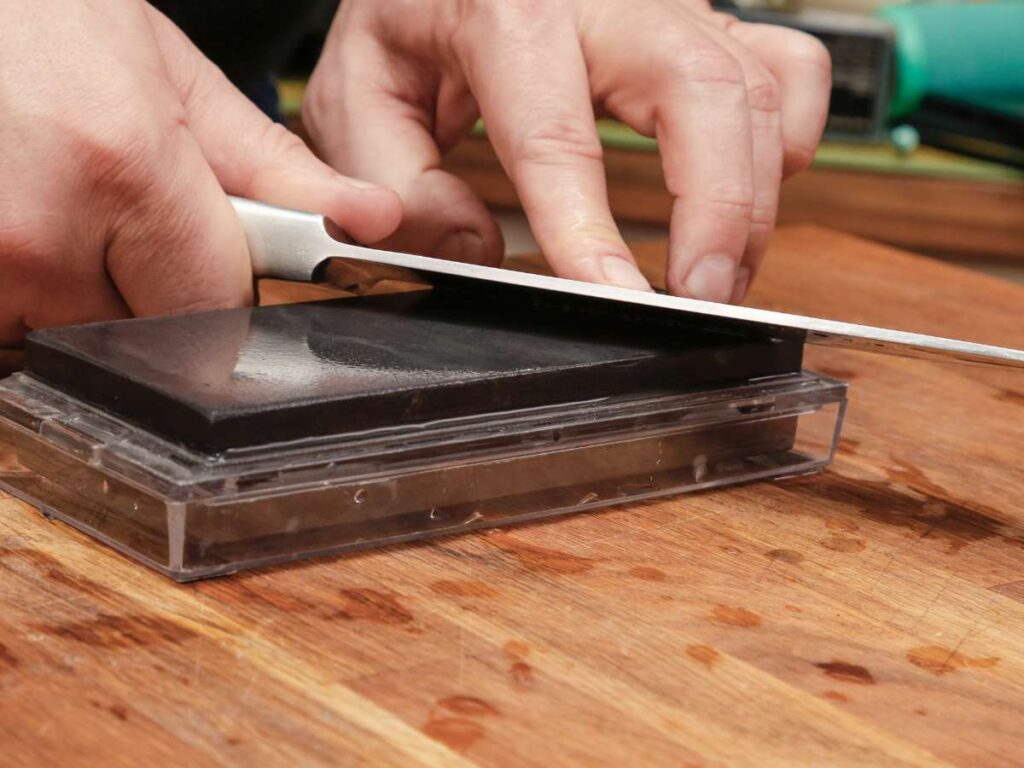
Proper care and maintenance will ensure your best camping and survival knife lasts for years to come. Here are some essential tips:
Cleaning: Taking proper care of your knife is a surefire way to ensure that it lasts for a long time. If used regularly, cleaning your knife should become part of your regular routine.
After each use, simply take a few moments to give the knife some attention. Use warm soapy water to cleanse the blade and any moving parts, such as on folding knives.
It might be tempting to just give the outside of the blade a quick rinse off, but doing this leaves bacteria behind where you can’t see it – NEVER skip cleaning any area of your knife!
With proper care and maintenance, you’ll be surprised at how your trusty knife continues cutting well into the future.
Drying: Taking care of your knife requires more than just cleaning it after each use. When it comes to storing, you should make sure to not only keep the knife safe from damage, but also away from moisture.
Especially for carbon steel knives, thoroughly drying the blade before placing it in storage is essential – neglecting this will result in rust and corrosion that can irreversibly damage and weaken the blade.
A few extra minutes taken to dry your knife can save you a lot of future headaches!
Sharpening: Keeping a sharp knife is essential for safe and efficient cooking.
Dull knives require more force to make a clean cut, which can be both dangerous and cause damage to delicate food items.
Tooling up with a honing rod or sharpening stone will help you keep your kitchen knives in the best condition possible. However, it’s important to take care not to over-sharpen blades or sharpen them too often; the metal is eventually worn away and less effective at cutting.
The key is striking the right balance between regular upkeep and taking extra care not to abuse your knife. So make sure you follow the manufacturer’s instructions for sharpening and adjust frequency according to how hard your knives need to work!
Lubrication: Nobody likes a jittery knife or multi-tool! Without proper lubrication, these handy tools can become difficult to operate.
The best way to keep them functioning smoothly is to apply a light lubricant specifically to the pivot area; this will make sure that the blade opens and closes as it should. Properly lubricated folding knives and multi-tools can last a lifetime; so make sure you are applying appropriate lubricants in the right places for optimal performance.
Making lubrication part of your regular maintenance of your tools will save you hassle down the line!
All in all, when outfitting yourself for an outdoor adventure, it is important to choose a great camping knife that perfectly suits all of your needs. Fixed blade knives are great for heavier tasks while folding knives offer convenience, and you should select one with the right type of blade material, such as carbon steel or a stainless steel blade.
Don’t forget to look for a knife with an ergonomic handle that fits comfortably in your hand, made of wood, synthetic material or metal. There are plenty of camping knifes available to suit any need so make sure to do your research before making a decision!
With the right camping knife, you will be prepared and equipped for every outdoors task. So now I want to hear from you – what type of knife are you currently using? Have you found one that meets all your criteria?
Leave me a comment below and let me know about your favorite camping knife!